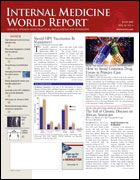Aberrant Crypt Foci: Emerging Biomarker for Colorectal Cancer
Aberrant crypt foci (ACF) are clusters of abnormal-appearing crypts seen under high magnification on the colonic mucosa. "Abnormal" usually refers to a larger size of a crypt foci with a thicker epithelial lining compared with the surrounding normal mucosa. The longstanding thinking of colorectal cancer development is that adenomas, spurred by acquired genetic mutations, can evolve into colorectal cancer. ACF have emerged over the past decade as the putative precursors to adenomas. ACF were initially seen on the colonic mucosa of rodents exposed to colorectal carcinogens. Animal studies had initially shown ACF to be an important predictor of colorectal cancer development. ACF were then discovered in pathologic specimens of human colon.
Magnification Colonoscopy
We now can detect ACF in patients using high-magnification chromoscopic colonoscopy (HMCC), a form of colonoscopy that produces a magnified image of the mucosa after it has been stained with methylene blue (Figure 1).
Figure 1. Abberant crypt foci
A typical ACF as seen via high-magnification colonoscopy.
Figure 2. Steps for high-magnification colonoscopy
Clean the colorectum by
enema or oral preparation
⇓
Insert colonoscope with
extra washing with water
⇓
Apply 10% Mucomyst to aid
in removal of mucous barrier
⇓
Additional washing
⇓
Spray 0.2% methylene blue
⇓
If ACF identified,
follow up with biopsy
Magnification colonoscopes, also called zoom colonoscopes, are marketed by several manufacturers. The magnifying ranges available vary between 13x and 150x and are viewed on a 20-inch monitor. Digital and optical magnification are available. Resolution, or the ability to detect object detail, is a function of pixel density. Since the resolution of a scope decreases with increasing magnification, magnification scopes are equipped with high-pixel density charged-coupled devices to maintain the quality of the image. Most high-magnification scopes have a ≥850,000- pixel charged-coupled device compared with the 100,000- to 200,000-pixel devices in conventional scopes. The range of observation can be wider, allowing the scope to get as close as 2 mm to the lesion, while maintaining resolution. The steps involved in ACF detection using HMCC are outlined in Figure 2.
Supporting Evidence
N Engl J Med
The landmark study (Takayama T, et al. . 1998;339:1277-1284) supporting the use of ACF as a biomarker for colorectal carcinoma was a large-scale analysis of ACF detected in vivo that was performed in Japan (n = 370). Some 55% of patients with a normal colon on colonoscopy had ACF (median, 1 per patient) in the lower rectum. The prevalence of ACF increased to 90% in individuals with adenomatous polyps, with a median number of 5 to 8 ACF in the rectum. Of those with a diagnosis of colorectal cancer, 100% had ACF (median, 25).
Several large-scale studies using HMCC have shown a significantly greater rate of ACF in patients with colon cancer and adenomas compared with persons with normal colon. Subsequent studies have used HMCC for in vivo rectal ACF detection, and a similar stepwise increase in the prevalence and frequency of rectal ACF in patients with a normal colon, adenoma, and carcinoma has been observed.
And ACF have been detected in up to 50% of patients who had completely normal colonoscopies otherwise. The genetics of ACF provide further evidence of its precancerous nature. Several mutations that have been known to occur in adenoma and colorectal carcinoma have been detected in ACF. Mutations in c-Ret, frequently found in sporadic colorectal adenomas and carcinomas, have been found in up to 90% of human ACF.
Are We Ready to Use ACF as a Biomarker for Colon Cancer?
There has been a lot of speculation, especially among gastroenterologists, about whether ACF detected by HMCC should be used to screen patients who do not have a polyp on screening colonoscopy. But inconsistencies in available studies suggest that more evidence is needed before we can implement HMCC clinically. The main obstacle is the variability in the results reported by the studies. For instance, the prevalence of ACF in patients with a normal colonoscopy varies between 15% and 100% in the published literature. The problem stems from different investigators using slightly different methodologies of the magnification endoscopy. For ACF to be a clinically useful biomarker, a reliably standardized method of identification and quantification is needed.
